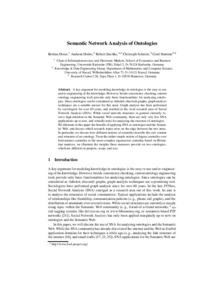Datum
2006Metadata
Zur Langanzeige
Preprint

Semantic network analysis of ontologies
Zusammenfassung
A key argument for modeling knowledge in ontologies is the easy re-use and re-engineering of the knowledge. However, beside consistency checking, current ontology engineering tools provide only basic functionalities for analyzing ontologies. Since ontologies can be considered as (labeled, directed) graphs, graph analysis techniques are a suitable answer for this need. Graph analysis has been performed by sociologists for over 60 years, and resulted in the vivid research area of Social Network Analysis (SNA). While social network structures in general currently receive high attention in the Semantic Web community, there are only very few SNA applications up to now, and virtually none for analyzing the structure of ontologies. We illustrate in this paper the benefits of applying SNA to ontologies and the Semantic Web, and discuss which research topics arise on the edge between the two areas. In particular, we discuss how different notions of centrality describe the core content and structure of an ontology. From the rather simple notion of degree centrality over betweenness centrality to the more complex eigenvector centrality based on Hermitian matrices, we illustrate the insights these measures provide on two ontologies, which are different in purpose, scope, and size.
Zitieren
@article{urn:nbn:de:hebis:34-2009042027026,
author={Hoser, Bettina and Hotho, Andreas and Jäschke, Robert and Schmitz, Christoph and Stumme, Gerd},
title={Semantic network analysis of ontologies},
year={2006}
}
0500 Oax
0501 Text $btxt$2rdacontent
0502 Computermedien $bc$2rdacarrier
1100 2006$n2006
1500 1/eng
2050 ##0##urn:nbn:de:hebis:34-2009042027026
3000 Hoser, Bettina
3010 Hotho, Andreas
3010 Jäschke, Robert
3010 Schmitz, Christoph
3010 Stumme, Gerd
4000 Semantic network analysis of ontologies / Hoser, Bettina
4030
4060 Online-Ressource
4085 ##0##=u http://nbn-resolving.de/urn:nbn:de:hebis:34-2009042027026=x R
4204 \$dPreprint
4170
5550 {{Ontologie <Wissensverarbeitung>}}
5550 {{Wissensmanagement}}
7136 ##0##urn:nbn:de:hebis:34-2009042027026
<resource xsi:schemaLocation="http://datacite.org/schema/kernel-2.2 http://schema.datacite.org/meta/kernel-2.2/metadata.xsd"> 2009-04-20T09:47:27Z 2009-04-20T09:47:27Z 2006 urn:nbn:de:hebis:34-2009042027026 http://hdl.handle.net/123456789/2009042027026 173087 bytes application/pdf eng Urheberrechtlich geschützt https://rightsstatements.org/page/InC/1.0/ 004 Semantic network analysis of ontologies Preprint A key argument for modeling knowledge in ontologies is the easy re-use and re-engineering of the knowledge. However, beside consistency checking, current ontology engineering tools provide only basic functionalities for analyzing ontologies. Since ontologies can be considered as (labeled, directed) graphs, graph analysis techniques are a suitable answer for this need. Graph analysis has been performed by sociologists for over 60 years, and resulted in the vivid research area of Social Network Analysis (SNA). While social network structures in general currently receive high attention in the Semantic Web community, there are only very few SNA applications up to now, and virtually none for analyzing the structure of ontologies. We illustrate in this paper the benefits of applying SNA to ontologies and the Semantic Web, and discuss which research topics arise on the edge between the two areas. In particular, we discuss how different notions of centrality describe the core content and structure of an ontology. From the rather simple notion of degree centrality over betweenness centrality to the more complex eigenvector centrality based on Hermitian matrices, we illustrate the insights these measures provide on two ontologies, which are different in purpose, scope, and size. open access Hoser, Bettina Hotho, Andreas Jäschke, Robert Schmitz, Christoph Stumme, Gerd Auch erschienen in: Sure, York u.a. (Hrsg.): The semantic web. (Lecture notes in computer science ; 4011). Berlin u.a. : Springer, 2006. S. 530-544. ISBN 3-540-34544-2 - 978-3-540-34544-2 (The original publication is available at www.springerlink.com) Ontologie <Wissensverarbeitung> Wissensmanagement </resource>
Die folgenden Lizenzbestimmungen sind mit dieser Ressource verbunden:
Urheberrechtlich geschützt

